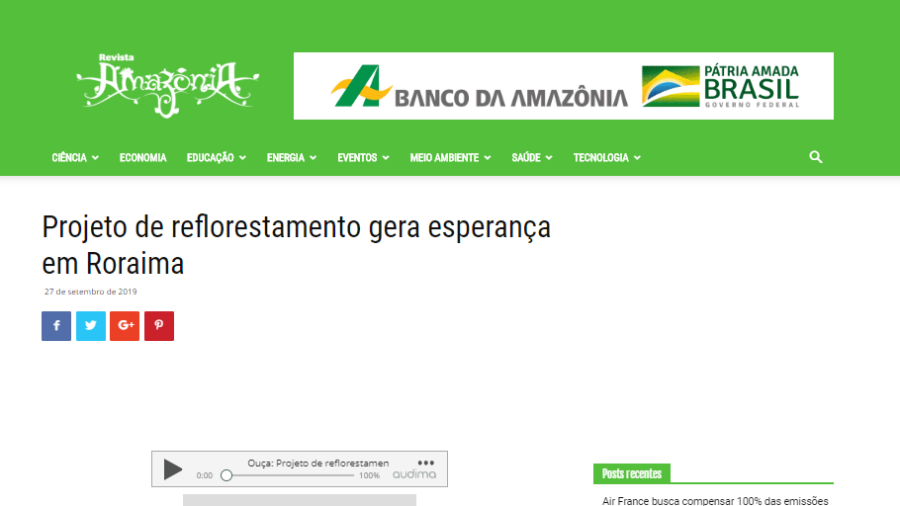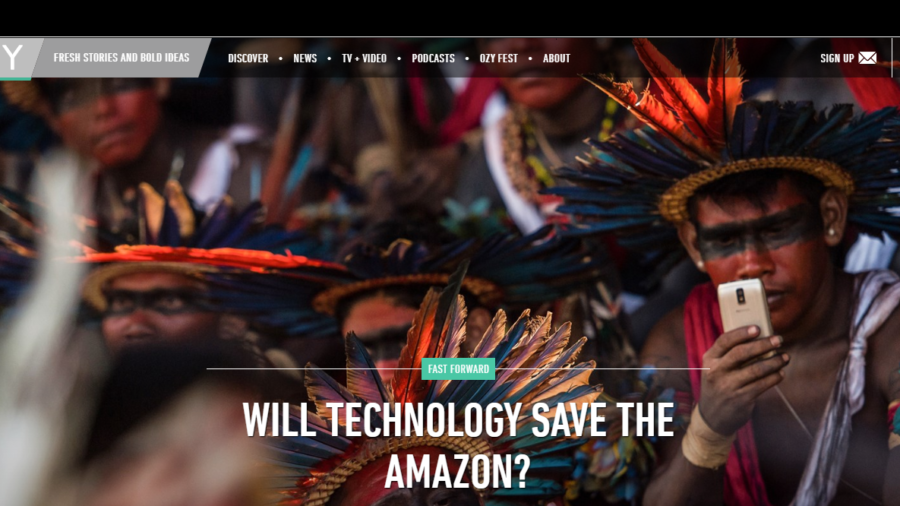
▲ After the appointment of Brazilian President Posonalo, the commercial interests of the Amazon rainforest were opened up, causing forest destruction to become widespread. (Figure / Dazhi, the same below)
When Jaime Sales climbed to the 3m high tree pile that was cut down and shouted “victory”, there was still smoke left above the Amazon rainforest; he put down the shotgun and continued to investigate the rainforest that was raging around. Saris is a pioneer in an environmental armed group, along with the Brazilian Para-Environmental Constitutional Police Force, deep into the jungle near Altamira in northern Brazil, where conflicts continue in the deforestation.He was worthy of his trip and seized a large amount of stolen timber, which is estimated to be worth millions of dollars. Experts believe that the timber could have been shipped to China, the United States or Europe. Saris said: “There are slight gains today; however, these environmentally damaging crimes have never stopped, and forest destruction has become rampant.” He pointed out that forest destruction is caused by illegal loggers, cunning farm owners, and Gold miners.
Brazilian President ignites the fire of deforestation
However, examples of successful Brazilian moratoriums are rare. Since the election of the president of Jair Bolsonaro on the far right last year, he has been eager to open up the commercial interests of the Amazon rainforest. The first three kinds of people will also benefit from the slashing of trees and the burning of forests. Although it has not set a historical record, the deforestation rate of the Amazon rainforest is still amazing this year. According to data released recently, the deforestation rate in August this year was 222% higher than that of the same period of last year; every minute there was a football field-sized forest area that was flattened. A mountain patrolman from the National Parks Management Office in Acre, western Brazil, said: “Since the election of Posonalo, the law has never been seriously enforced, the rain forest has suffered, and people have set fire to the forest because they know that no one is banned.”
Posonalo and his allies believe that tropical rain forests are natural resources and should be developed, especially in Brazil where so many people live in poverty or near poverty. The attention of the international community to the Amazon rainforest is seen as a blatant stalking of Brazil’s development, and the natural habitats of these rich countries have been destroyed.
The attitude of Posonalo in the Amazon woodland has caused public outrage in the world. This dissatisfaction also adds motivation to the various views and discussions on how to manage the rainforest. Scientists, entrepreneurs and environmentalists believe that advances in science and technology can promote sustainable development and solve forest damage problems.
For them, the key to not letting the role of the bullying Amazon rainforest succeed is to show that land conservation is economically profitable and valuable to the environment. They believe that the Amazon rainforest is the world’s largest resource for biodiversity and a potential base for a multi-million dollar bioeconomy, but only if scientists can resolve and exploit the genetic code of the Amazon rainforest’s diverse wildlife.
Since the end of the 1980s, the fate of the Amazon rainforest has become a global issue. The debate on the sustainability of the rainforest has lasted for 30 years, but for many scientists, a new generation of tools such as genome sequencing, satellite tracking forest reconstruction, etc. It can strengthen the salvation of the Amazon rainforest that is related to the climate model. Juan Carlos Castilla-Rubio, chairman of Space Time Ventures in Brazil, said: “If 100% of the complex life genes maps on the planet are resolved, we can open up a lot of new inventions and new industries that we have dreamed of. This is what we call the new biological economy.”
The rainforest was disappeared and brought human catastrophe
However, the situation is becoming increasingly critical. Some scientists worry that the world’s largest rainforest, which absorbs carbon dioxide emissions and controls global temperature rise, may be close to a key “tipping point”. Once this limit is exceeded, there will not be enough trees on the earth to maintain the water cycle ecology. system. In the past, scientists believed that when 40% of the Amazon rainforest was destroyed, the tipping point would come; but George. Tom Lovejoy of Geroge Mason University and Carlos Nobre of the Brazilian World Resources Institute now argue that when 20 to 25% of the tropical rain forests disappear, the balance begins to tilt.
Casdia Rubio’s office in the suburbs of São Paulo has brought in some of Brazil’s golden minds, including artificial intelligence researchers, big data experts and biochemical scientists. They are committed to using new technologies to protect the rainforest and other threatened areas in Brazil. Casdia Rubio said: “I am worried that climate change will be like a dislocated horse, causing frequent disasters – crop failure, water shortages, social unrest. You can’t predict when and where the worst will happen, but these The signs all point in the same direction and are irreversible.”
The Casdia-Rubio team uses big data and satellites to help farmers increase farmland output and reduce agricultural land expansion to the edge of protected tropical rainforests. A project also uses satellites to pinpoint and classify specific types of weeds, which are then surgically precision weeded by drones. He said: “If you know exactly where and what kind of weeds, you can use one-third of the herbicide, which means only polluting the previous one-third.”
Farmers across Brazil use similar technologies, they are aware of the sensitivity of the environment and the importance of farms to adapt to extreme weather more efficiently. Edwin Montengro, a farmer who grows Hawaiian beans, said: “The key is that we know we have to conserve. We know we don’t have more land to develop.” Montangro uses biological fertilization technology to improve soil and The quality of the crop.
Scientists new technology to save the earth
The goal of scientists is not only to improve the sustainability of agriculture in the Amazon, but also to analyze the genetic map of the abundance of wildlife in the Amazon rainforest, and to change the way to protect the rainforest. Although the Amazon rainforest is recognized as the most biologically diverse ecosystem on the planet, less than 1% of the rainforest complex life DNA is sorted out. Cassidia Rubio, a biochemist from the University of Cambridge, believes that once the results of the genetic map are transferred to the industry, there will be huge economic opportunities. He said: “So far, we have only measured 0.28% of the complex life on the earth, but this 0.28% of knowledge is the foundation of the pharmaceutical, chemical, materials, fuel and other industries, bringing annual sales of at least 4 trillion US dollars. .”
A team of environmental scientists in the European Union wrote in the July issue of Science: “One of the most promising options for protectionists is to reforest on illegally razed land.” One of the “most effective” methods of mitigating climate change. However, the afforestation process is time consuming and expensive and often in vain. Marcello Guimaraes, chairman of Mahogany Roraima, a commercial timber and plantation park in the Northern Amazon rainforest, said: “Afforestation is a very complicated job, like a living system, a whole. You must ensure that everything is right in your heart and stomach. In terms of location, building an artificial body requires a lot of research.”
Planting each tree requires not only sunshine and shading but also other trees that interfere with growth. Similarly, planting a single species increases the risk of disease and therefore requires a carefully arranged combination of species. This usually needs to be performed by professional tree planters, and there are few such talents in the Amazon region. In addition, Guimaras said that some species, like oil-bearing trees, are easy to grow but do not provide habitat for the prosperity of biodiversity species, and they become so-called “dead zones.”

The best solution: reforestation and warming
According to the Paris Climate Agreement, Brazil promises that by 2030, the afforestation will reach 12 million hectares, but at the current rate, it is unlikely to be done. Guimaras believes that the solution involves convincing landowners and farmers to adopt new technologies with obvious economic benefits. Merchants in Roraima have used satellites to monitor land-based automatic planting machines, and the planting area can be increased from 200 hectares per day to 100 hectares per hour.
According to Brazilian regulations, only 20% of forest farms are used for commercial purposes and 80% must be reserved for reforestation. “Our focus is on developing commercial business, but afforestation is very important to this process. If we can develop as a business, we can compete with those who are deforestation,” said Guimaras.
The idea of creating economic incentives is affirmed by the Amazonas Sustainable Foundation. Foundation executive Virgilio Viana said: “We let the world know that sustainable use can be used to improve livelihoods and achieve change.” He pointed out that in areas where they worked hard, rainforest damage was reduced by 60%. .
However, Viana is concerned that the sign of encouragement from Posonalo to illegal loggers has made the work of non-profit groups more difficult. Posonalo has publicly attacked the environmental agency Ibama, and even accused NGOs of being the culprit behind several fires in the Amazon rainforest. Viana said: “If the cost of illegal deforestation is reduced, then the competitiveness of sustainable development will also be reduced, and the economic balance will change.”
See the original article(in chinese) clicking here.















